What Are the Parts of a Sink? (with Detailed Diagram)

Repairing a sink or installing a new sink may seem like an overwhelming task. However, sinks are not all that complicated when you break them down to their parts and how they function. Once you learn the basic parts of a sink and how they function you should be able to perform any basic DIY sink repair, and even a new sink installation.
The basin, drain, faucet, and controls are the main parts of a sink. Components such as the water supply lines, P-trap, and the tailpiece are the parts of a sink necessary for it to function. The cleanout allows you to remove clogs, and the shut-off valve lets you control the flow of water.
Fortunately, learning the parts of a sink, along with the proper orientation, is all that is required to take on standard maintenance and installation tasks. Whether you’re concerned with your kitchen sink or your bathroom sink, being aware of its parts can prove to be very useful.
Do You Need to Hire Sink Installers?
Get free, zero-commitment quotes from pro contractors near you.

Parts of a Sink
Although sinks vary in style, function and design, many of the following parts exist on all sinks, regardless of the purpose they serve in the home.
- Basin: Arguably the most crucial part of a sink, the basin’s purpose is to hold the water from the faucet. Basins are outfitted with a drain at the bottom to allow the water to escape. They come in a variety of shapes, sizes, materials, and styles for kitchen, bathroom, and utility sinks.
- Drain: Every sink will have a drain that allows the water from the faucet to flow out of the basin. The drain is connected to the P-trap and plumbing connections hidden under the sink and within the walls.
- Faucet: Put simply, the faucet is the part of the sink that supplies water. The sink faucet can be broken down further into the controls, water spout, flanges, aerators, gaskets, and an assortment of screws and washers depending on the type of bathroom or kitchen sink faucet you have in your home. Faucets can be found in various materials, but in most cases, they are made of stainless steel. Additionally, they can be mounted on the countertop on the sink itself.
- Controls: The controls are what are used to turn the water on and off. There are a variety of different styles to fit your particular needs. Separate hot/cold left and right controls are popular, while a single lever attached to the faucet that rotates to control water temperature is also common.
- Water Supply Lines: Also found on all types of sinks, the water supply lines are attached to the controls on the sink’s faucet. When the controls are initiated, hot and cold water travels through these lines to the sink for use.
- Tailpiece: Typically referred to as the ‘drain tailpiece,’ this is the area of piping that is directly connected to the drain fitting. Once water exits the drain, the tailpiece carries water away from the sink.
- P-Trap: Sometimes just called the ‘trap,’ the P-trap exists in two parts and can be found underneath your sink. It allows water and waste to pass through. The bend in the pipe is what traps the waste and prevent sewer gas odors from seeping into your home.
- Cleanout: Found near the P-trap, the cleanout is a pipe fitting that allows you to easily access clogs and remove any debris from the piping.
- Shut-off Valve: Typically outfitted with an oval-shaped handle connected to a flexible braided metal line, a shut-off valve is located near a sink to help control the flow of water. By simply turning the shut-off valve, you can cut off the supply of water to the sink without having to turn off the water in the entire house. These individual shut-offs are often referred to as ‘stops.’
The Anatomy of a Kitchen Sink
A kitchen sink is a home essential for most people. These sinks facilitate many essential day-to-day functions in the home. These functions include dishwashing, wastewater disposal, producing drinking water, hand washing and many other uses. Kitchen sinks have most of the same standard parts you find on all standard sinks.
This means your will find a faucet, controls, shut-off valve, water supply lines, and basin. Additionally, because kitchen sinks serve many purposes and are complex, they often come with several parts that other sinks do not.
Here are some of the common parts of a kitchen sink assembly:
- Spray Head: Spray heads share the same water supply as your faucet through a connecting spray house and are detachable to make washing dishes much easier. Most kitchen sink setups only allow you to use either the faucet or spray head, but never both at once.
- Escutcheon: This term refers to the piece attached to your faucet or faucet lever. It is a flat piece of metal that conceals the hole for the water supply lines and coupling compressor underneath.
- Strainer: The strainer consists of multiple pieces including a strainer body, a flange, and a coupling. This system connects to your drain and is designed to filter out debris.
- Garbage Disposal: Although not found on all kitchen sink assemblies, the garbage disposal is a helpful device for grinding up food debris and then distributing it away from the sink. It is found underneath the sink and is attached to the drain and the P-trap.
- Stoppers: Stoppers are designed to help collect food waste and are generally detachable. That way you can use the garbage disposal as necessary. For kitchen sinks, it’s very common to use a separate stopper basket.
The Anatomy of a Bathroom Sink
A bathroom sink is normally less complex than a kitchen sink. Bathroom sinks normally contain fewer parts than the standard kitchen sink. However, they still feature the same universal parts such as the basin, faucet, water supply lines, and controls. Additionally, there are parts found in bathroom sinks that are often missing from a kitchen sink design.
- Stoppers: Most bathroom sinks are equipped with a drain that can be closed when needed to keep water in the basin. The devices that allow you to close the drain are called stoppers. They consist of a fitting that is housed inside the drain and a lift rod to lift and lower the stopper valve. The mechanism is activated with the assistance of a clevis trap, spring clip, pivot rod, and relevant hardware.
- Valve Stops: Although these are also found on kitchen sinks, they differ slightly in the bathroom. Most bathroom sinks have separate shut-off valves for hot and cold water. By turning the respective handle, you can turn the water off without disrupting the toilet, shower, or other fixtures in your bathroom.
Parts of a Sink Drain
Although sink drains aren’t substantially complicated, they may be difficult to understand if you’re new to the plumbing world. There are quite a bit of pieces involved, however here are the parts of a sink drain that you should be familiar with:
- Strainer Basket: Usually an optional product, the strainer basket rests in the drain opening in your sink basin. Its job is to collect food waste and prevent it from going down the drain. Many sinks come with strainer baskets or you can purchase a universal replacement to fit your sink. This drain part is not typically found in bathroom sinks.
- Strainer Flange: The strainer flange is situated just underneath the strainer basket. When relevant, this piece is directly attached to the garbage disposal.
- Rubber Gasket, Strainer Nut, and Friction Gasket: A rubber gasket is a seal located under the strainer. It serves as a protective barrier, preventing leakage of liquid or gas. Along with the strainer nut and the friction gasket, the rubber gasket creates a strong seal between the P-trap and strainer flange. These pieces are usually fastened in place with plumber’s putty.
- P-trap: As previously mentioned, the P-trap consists of two pipes for removing waste and water from your sink. The pronounced bend helps prevent clogs and keep sewer gases from escaping out of the drain.
Do You Need to Hire Sink Installers?
Get free, zero-commitment quotes from pro contractors near you.

Parts of a Sink Faucet
The final major piece of a sink, whether it’s your kitchen or bathroom sink, is the faucet. Your sink’s faucet consists of a number of parts, including:
- Faucet Body: Once installed, this piece is nonadjustable. It is the main part of the faucet that connects to the water supply to service water out of the spout.
- Faucet Lever: Found either on top of the faucet body or on either side, the faucet level controls the water supply and turns the water on during normal operation. The lever also allows you to control the temperature of the water.
- Spout Assembly: The spout and spout assembly are the inside and outside components to let water flow out of the faucet body.
- Aerator: Found at the end of the spout, the aerator regulates the flow of water from the spout.
- Compression Couplings: These devices are designed to connect two different pipes to your valves and fixtures. They are covered by the escutcheon and are found between the left and right valves and the hot and cold water supply lines.
- Dishwasher Drain Hose: If your kitchen has a dishwasher, the drain hose’s purpose is to remove wastewater from the dishwasher.
In addition to the aforementioned parts, sink faucets use a variety of washers and nuts to fasten the pieces together. However, these will vary depending on the individual hardware your sink has.
Related Questions
What is the drain assembly for a sink?
The drain assembly for a sink links the P-trap to the rest of the sink. A flange and stopper connect to a drain tube. The drain tube connects to a ball and rod assembly that allows the drain assembly to pop up and down.
What are the parts of a faucet called?
Cartridges, stems, aerators, and flow restrictors are the main parts of a faucet. The washers, escutcheons, flanges, and O-rings are key to a faucet’s function. Caps, index buttons, and handles allow you to adjust the water flow on a faucet.

Jessica considers herself a home improvement and design enthusiast. She grew up surrounded by constant home improvement projects and owes most of what she knows to helping her dad renovate her childhood home. Being a Los Angeles resident, Jessica spends a lot of her time looking for her next DIY project and sharing her love for home design.
More by Jessica Stone




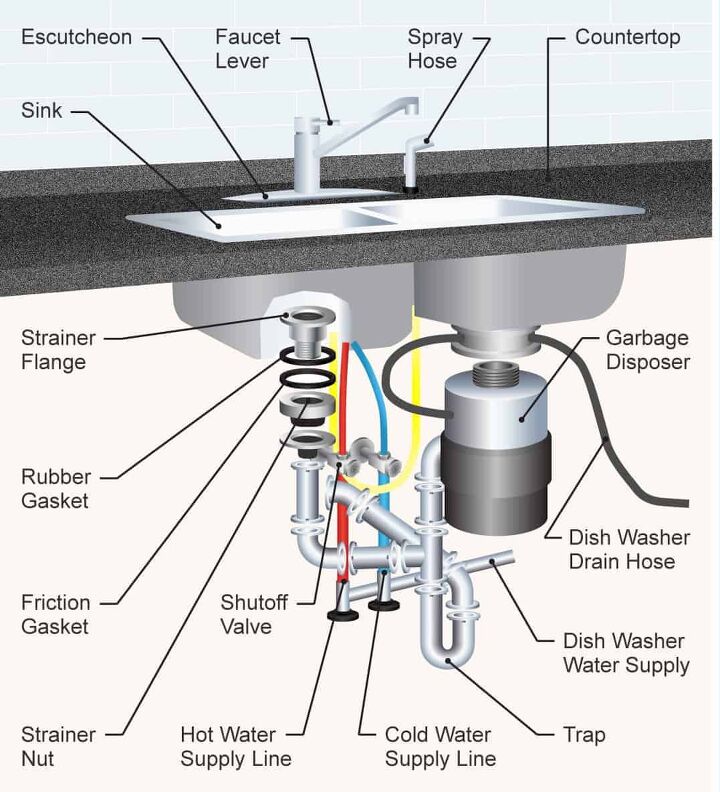








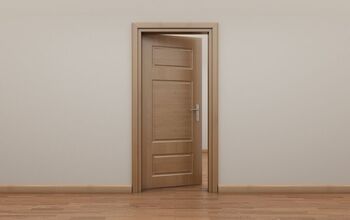
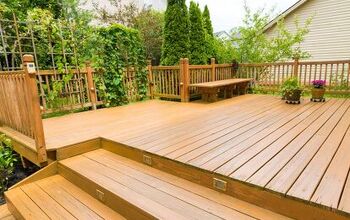
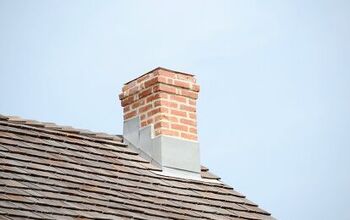
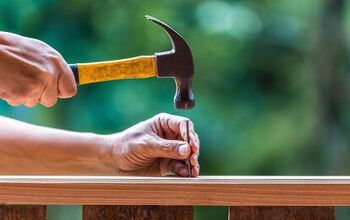

![12 Washing Machine Brands to Avoid [with Recall Data]](https://cdn-fastly.upgradedhome.com/media/2023/07/31/9075781/12-washing-machine-brands-to-avoid-with-recall-data.jpg?size=350x220)










